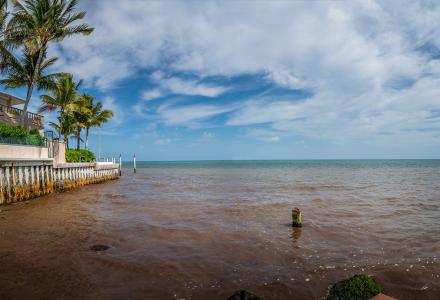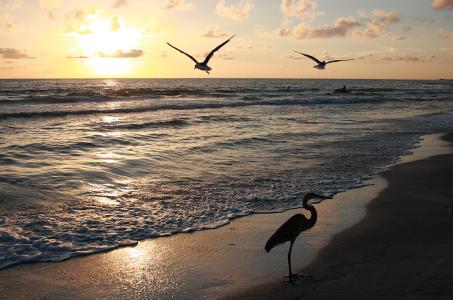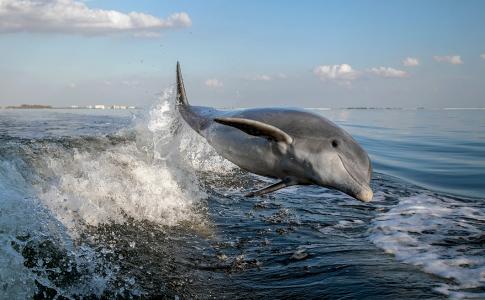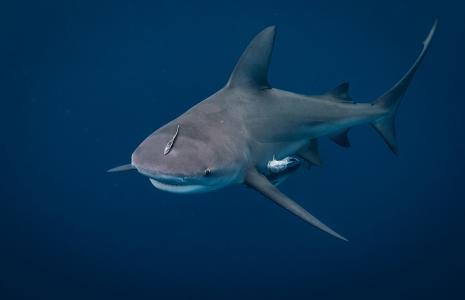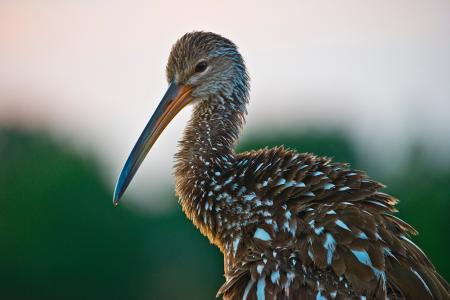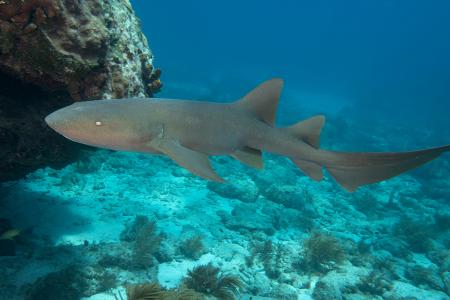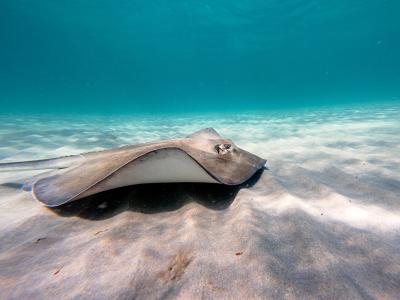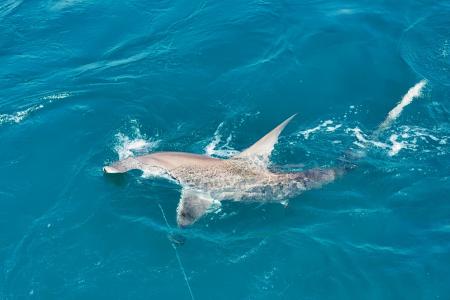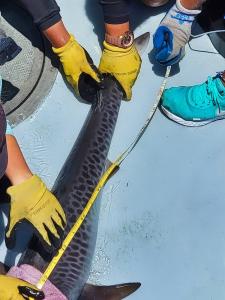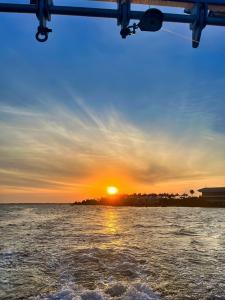Please read the following information carefully before leaving for your expedition.
Tracking Sharks and Rays in Florida
Expedition Briefing
Quick Navigation: COVID-19 Safety | The Research | Research Aims | How You Will Help | Life in the Field | Accommodations and Food | Project Conditions | Essential Eligibility Requirements | Health and Safety | Project Risks and Precautions | Travel Planning | Additional Resources
Click on the images to view full size!
COVID-19 Safety
You are strongly encouraged to test for COVID-19 before traveling to your expedition, particularly if you are experiencing symptoms. Do not travel if you have tested positive, and call Earthwatch right away for the next steps. Please see earthwatch.org/covid-19 for more information.
The Research
In the 1950s, Dr. Eugenie Clark (often referred to as the "Shark Lady") founded a small research lab in Sarasota, Florida. Among other studies, she and her team researched locally abundant sharks and rays (Clark and von Schmidt 1965). That laboratory eventually grew into Mote Marine Laboratory & Aquarium, which still houses one of the world's oldest and largest shark and ray research programs.
Since Dr. Clark's era, sharks have experienced massive population changes off Sarasota and in the U.S. Atlantic and Gulf of Mexico more broadly (Peterson et al. 2017). A shark fishing boom occurred in the 1970s and 1980s, led to severe population declines (Peterson et al. 2017). Mote scientists established local shark surveys and research programs aimed at guiding state and federal shark management policy. These surveys continue today and, combined with other research, have revealed that sharks are beginning to recover in U.S. waters under a science-based management regime (Peterson et al. 2017).
With the Shark Finning Prohibition Act in 2000 and the Shark Conservation Act in 2010, the U.S. has built some of the world's strongest regulations on shark fishing. Today, the number of sharks that can be caught is highly regulated to ensure the fishery is sustainable. These state and federal catch limits continue to be based in part on Mote’s longstanding shark survey.
Aboard a research vessel named for the groundbreaking Shark Lady, Earthwatch volunteers will help continue Dr. Clark’s work to survey shark populations off the coast of southwest Florida. The data you help collect will aid researchers in determining whether shark management is effectively regulating shark fisheries and direct regulators to alternative management strategies for shark species that are not recovering adequately.
This project will also launch a new initiative to survey small shark and stingray populations inside Sarasota Bay. Currently, ray populations are not assessed by the state or local government; however, an emerging threat known as red tide is impacting these species' biodiversity and ecological function. Red tide occurs when the algae species Karenia brevis rapidly increases, which is called an algal bloom. Usually, algae are invisible to the naked eye, but during these population booms, there are so many Karenia brevis that they may turn the water red. These red tides can cause massive fish die-offs and the deaths of marine mammals, sea turtles, and sea birds.
Unlike many other marine animals, small sharks and rays cannot leave the bays, where red tides are most likely to occur, so they are more likely to be exposed and die. While red tides occur naturally, human activities are causing them to happen more frequently. Chemicals from farming, sewage treatment plants, and other sources can dissolve in the water and cause algae to grow faster, leading to a harmful algae bloom. The abundance and biodiversity of small sharks and stingrays need to be established to determine how increasingly frequent red tides impact ray populations and their effects on Sarasota Bay’s ecosystems.
Tracking Sharks and Rays in Florida
Research Aims
This project addresses two major research objectives. The first is maintaining Mote Marine Laboratory & Aquarium’s shark survey off the Sarasota coast. The second objective is to establish a new inshore stingray survey.
These objectives will address the following research questions :
- What are the species-specific population trends for sharks off the Sarasota coast, and are all managed species recovering?
- Are sharks larger today than 20 years ago due to lower fishing pressure?
- Are stingrays declining in Sarasota Bay because of red tide?
The data collected through this program will feed directly into federal shark assessments, which are used to set shark catch limits and promulgate additional management measures when needed. The research staff also uses these data to conduct their analyses to determine the status of sharks in southwest Florida and compare the species composition to what Dr. Eugenie Clark observed in the 1950s.
Tracking Sharks and Rays in Florida
How You Will Help
Each season, Mote needs to complete a minimum of four days of the large shark survey (hereafter referred to as “LSS”) along the coast and four days of ray and shark surveys in Sarasota Bay (hereafter referred to as the “RSSS”). This will allow us to meet our core objective of understanding species' population trends across both habitats. Since we have two Earthwatch expeditions per season, we will make every attempt to conduct some LSS and some RSS days in each expedition. It is important to stress that we cannot guarantee that all expeditions will get the same amount due to weather conditions and the need to achieve four days of each. For example, if inclement weather occurs during one expedition, we may be forced to focus on RSSS and stay in the bay because it is usually calmer there. That would then mean the next expedition would focus on the LSS due to the deficit in data from the coast. We appreciate volunteer flexibility and understanding that the schedule depends on weather, safety, and sampling needs.
The LSS and RSS require a great deal of sampling, and it takes a large team to keep up with the physical demands of this much fieldwork. You will be part of this team to conduct the following activities:
Large Shark Survey (LSS): Catching sharks by longline and drumline (along the coast).
For the LSS, we will follow the standardized gear and sampling locations used by Mote every year for nearly two decades. Activities will be conducted from our large research vessel, the Eugenie Clark (a large vessel with a cover and a toilet). Ten drumlines and a longline will be deployed each day in two locations per expedition. Locations include Anna Maria Island, Longboat Pass, New Pass, and Midnight Pass. Drumlines will be set twice daily at two different depths, and the longline will be set once daily. The hooks will be baited with fish bait. Volunteers will then assist researchers in checking these lines. All sharks captured will be identified, sexed, measured, and fin-clipped for population genetics studies. All sharks will be tagged with Mote tags and released alive when alive at capture. All non-shark catch will be measured and returned to the water. The primary shark species we catch are sandbar (Carcharhinus plumbeus; winter), blacktip (C. limbatus; spring-summer-fall), bull (C. leucas; spring-summer-fall), nurse (Ginglymostoma cirratum; summer), tiger (Galeocerdo cuvier; all year but winter-spring peak), great hammerhead (Sphyrna mokarran; spring-summer), and lemon (Negaprion brevirostris; spring-summer). The catch-per-unit effort will be used to assess the effects year on populations of sharks along the coast. Note that the LSS is highly weather-dependent, and it is the most difficult part of the research to schedule.
Ray and Small Shark Survey RSSS): Catching rays and small sharks on baited cameras and longlines (inside Sarasota Bay).
In this new initiative, volunteers will help use a combination of baited underwater remote video systems (BRUVS) and longlines to survey stingrays and small shark species inside Sarasota Bay. We will operate from a smaller vessel that lacks cover and does not have a bathroom. BRUVS are deployed from the vessel and collected after soaking for a few hours. Longlines are deployed and retrieved after 1-2 hours. Captured rays may include southern stingrays (Hypanus americanus), Atlantic stingrays (H. sabinus), and bluntnose stingrays (H. say). Sharks caught can include any of the LSS species above (all rare) plus more commonly encountered small species: blacknose (C. acronotus) and bonnethead (S. tiburo). Captured animals will be brought on board and placed in a live well so the team can sample, measure, tag, and release them. The catch-per-unit effort will be used to assess the effects of seasonal red tide on the bay’s populations of stingrays and sharks. Note that the RSSS is often achievable even on days when the LSS is impossible. However, if we have a good weather window, we may focus on LSS and do fewer RSSS days on a given expedition.
Collect environmental data at each survey location.
At each deployed location, volunteers will assist in collecting a variety of physical data. This includes the depth range, tide, salinity, conductivity, dissolved oxygen, temperature, bottom type, and weather conditions.
Prepare bait and maintain equipment.
Volunteers will aid research staff in preparing bait for the sharks and rays, loading the equipment on the research vessel, deploying and retrieving gear, cleaning gear after fieldwork, and unloading the vessel at the end of the trip.
Maintaining our captive animals
The Sharks and Rays Conservation Research Program maintains the Marine Ecological Research Facility (MERF), which houses several species of sharks and rays for research purposes. In addition to fieldwork, volunteers will assist us in animal care, which will entail food preparation, feeding, and checking water chemistry.
Tracking Sharks and Rays in Florida
Life in the Field
Weather and research needs can lead to changes in the daily schedule. We appreciate your cooperation and understanding. Although we provide an itinerary below, this is only a general idea of what will happen.
ITINERARY
Day 1: Arrival
- Meet at the rendezvous point at 3:00 p.m.
- Basic introduction to the project and team.
- Settle into accommodations (“home base”).
- Make a food shopping list for the next day (for breakfasts and lunches, which are all self-made).
Day 2: Training
- The group will spend the day being trained in sampling and data collection methods at Mote Marine Laboratory & Aquarium.
- The group will be trained to feed and care for our in-house study animals.
- The group may load the vessel for the next day’s sampling activity.
- Dinner at home base.
Days 3–6: Survey Days
- The whole team will spend the day conducting surveys. If it is LSS this activity entails up to 12 hours per day on the larger research vessel. If it is RSSS this activity is 6-8 hours on a smaller research vessel.
- Start early (6:00 a.m.) if LSS, and later start if RSSS.
- Bring a packed lunch and all your personal field gear for the day.
- Dinner at home base.
Day 7: Rest Day
- Free tickets and a behind-the-scenes tour of Mote Marine Laboratory & Aquarium
- Volunteers will be allowed to explore Sarasota in the afternoon (optional).
- Evening dinner and wrap up with Mote staff at the home base.
Day 8: Departure
- All volunteers depart the home base by 9:00 a.m.
Tracking Sharks and Rays in Florida
Accommodations and Food
* Please note that not every expedition has couples or single accommodations available. Please call or email Earthwatch to check availability before reserving your space(s) on the team.
SLEEPING
A large AirBnB rental house in Sarasota's suburbs will be used as a home base for the expedition. It will have a mix of single and double or triple occupancy rooms. Room assignments will be made based on the gender mix of the team.
* Earthwatch will honor each person’s assertion of gender identity respectfully and without judgment. For both teen and adult teams, where logistics dictate single-sex accommodations or other facilities, participant placements will be made in accordance with the gender identity the participant specified on their Earthwatch Participant form and/or preferences indicated in discussions with Earthwatch.
BATHROOMS
The rental house will have a minimum of 2 full bathrooms.
ELECTRICITY
The rental house will have standard US voltage and power outlets in all sleeping and common areas.
PERSONAL COMMUNICATIONS
Volunteers will have full access to cell phones and the internet, although cell phone use on the vessels will be discouraged for safety reasons.
Please note: Personal communication with outsiders is not always possible during an expedition. Earthwatch encourages volunteers to minimize outgoing calls and immerse themselves in the experience; likewise, family and friends should restrict calls to urgent messages only.
DISTANCE TO FIELD SITE
The boat launch will be a 20-minute drive from the rental house. From there, you will take a 15 to 60-minute ride in the research vessel to the location where sampling gear will be deployed.
FOOD AND WATER
The rental house will be stocked with basic American foodstuffs before your arrival to enable you to prepare your breakfast on Day 2. The group will make a shopping list for breakfast and lunch foods that are self-catered from Day 3 onwards, with breakfast being eaten at the home base and lunch being packed and eaten on the research vessel. This will include cereal, bread, fruit, condiments, eggs, breakfast and lunch meats, snacks, coffee, tea, milk, and juice. Additional snacks will be carried by Mote staff in the field. Dinners will be catered and determined based on volunteers' dietary needs and preferences.
SPECIAL DIETARY REQUIREMENTS
Please alert Earthwatch to any special dietary requirements (e.g., diabetes, lactose intolerance, nut or other food allergies, vegetarian or vegan diets) as soon as possible and note them in the space on your participant forms.
This project can cater to all dietary requirements and preferences.
Tracking Sharks and Rays in Florida
Project Conditions
GENERAL CONDITIONS
Please visit Wunderground.com and search for your project location for weather and region-specific information.
Tracking Sharks and Rays in Florida
Essential Eligibility Requirements
All participants must be able to:
- Wear all protective equipment recommended or required by industry standards.
- Work on a boat for approximately four to five hours per day with limited break options (e.g., no bathroom on the boat, except for the ocean or the islands where we will stop).
- Maintain a seated, upright position within the boat during transit, which can sometimes be bumpy. This can be uncomfortable for individuals with back problems.
- Enjoy being outdoors all day in all types of weather and the potential presence of wild animals and insects.
- Endure tropic (hot and humid) work conditions.
- Be comfortable with living in and moving between remote study sites.
- Follow verbal and/or visual instructions independently or with the assistance of a companion.
- Take an active role in your safety by recognizing and avoiding hazards if and when they arise (including, but not limited to, those described in Earthwatch materials and safety briefings). Always comply with project staff instructions and recommended safety measures.
- Effectively communicate to the staff if you are experiencing distress or need assistance.
- Get along with a variety of people from different backgrounds and ages, often in close proximity, for the duration of your team.
- Be comfortable surrounded by a language and/or culture different from yours.
Tracking Sharks and Rays in Florida
Health and Safety
EMERGENCIES IN THE FIELD
Project staff members are not medical professionals.
Earthwatch has a 24-hour, 7-day-a-week emergency hotline number. Someone is always on call to respond to messages that come into our live answering service.
IMMUNIZATIONS & TRAVEL VACCINATIONS
Please be sure your routine immunizations are up to date (for example, diphtheria, pertussis, tetanus, polio, measles, mumps, rubella, and varicella) and that you have the appropriate vaccinations for your travel destination. Medical decisions are the responsibility of each volunteer and their doctor. Visit the Center for Disease Control and Prevention or the World Health Organization for guidance on immunizations.
If traveling from countries or regions where yellow fever is endemic, you must have a certificate of vaccination.
It is strongly encouraged that you stay up to date with your COVID-19 vaccinations, including receiving booster doses, as applicable.
Tracking Sharks and Rays in Florida
Project Risks and Precautions
TRANSPORTATION
We will travel on public roads with few traffic issues, but the risks inherent in road travel still apply. All volunteers will have a seat belt and must wear it whenever the vehicle is in motion. Volunteers are not permitted to drive.
ANIMALS/ PLANTS
Working with sharks and stingrays alongside or in a boat is inherently dangerous. Most sharks and stingrays we work with are hooked in the mouth and are secured before the workup. Teams will be heavily supervised during this activity and will not touch sharks forward of their dorsal fins.
Potentially dangerous animals that could be encountered while snorkeling include sharks, stingrays, sea urchins, lionfish, and jellyfish. Although rare, saltwater crocodiles have been seen. Staff will train you to identify dangerous species and avoid touching organisms. Those with a severe allergy to bee or wasp stings may have a similarly dangerous reaction to corals and jellyfish. They must always carry an EpiPen and notify staff of its location.
INSECTS
Sand flies (also known as “sand fleas” or “no-see-ums”) and mosquitoes are nuisances throughout the year. Sand flies are believed to be a vector for leishmaniasis in some regions. Some find them to be only irritating, but people occasionally react badly to the bites. Please come prepared with an oral antihistamine that you know you can tolerate and a topical anti-itch cream. Those traveling from outside the Americas may react more severely to bites. To avoid sand flies, wear lightweight, long pants and socks in the evening (they generally bite from the knees down). Mosquitoes may transmit several diseases, including malaria and the Zika virus (see the Safety section for more information). Repellents containing DEET work well against mosquitoes. Wear lightweight, long pants, shirts, and socks in the evening to avoid them.
CLIMATE/WEATHER
The subtropical sun is very intense. Please bring plenty of good-quality waterproof sunscreen at several SPF levels. You will also want to bring after-sun lotion to soothe your skin after a long day in the sun. Some volunteers have found it helpful to bring long-sleeved, lightweight, quick-drying shirts and long pants to wear. Note that December in Florida is cold, especially when on a boat, so teams fielding during this period should pack warm clothes. A hat with a wide brim and a neck gaiter or loose scarf are recommended, as are polarized sunglasses and a chord to secure them around your neck. With the sun comes heat and risks of overheating and dehydration. Both can lead to illness. Drinking water frequently and minimizing exposure to the sun will help make your experience more enjoyable. Brief periods of intense rain are not uncommon, so a sturdy rain jacket is mandatory. More extreme tropical storms and hurricanes traditionally occur from June through November, with late August, September, and October being the most active periods. A hurricane plan exists and will be followed in the case of an extreme weather event. Because of the high humidity, people who use a hearing aid may find it doesn’t work properly. Consider purchasing a hearing aid dehumidifier.
PROJECT TASKS/EQUIPMENT
We will work with sharp items (hooks) and bait (spines). Volunteers will be issued gloves and will be trained in the safe handling of these items.
WORKING ON A BOAT
Working aboard a small boat poses risks. Bouncing or jostling can be quite uncomfortable for volunteers with chronic back problems or a history of seasickness. Boat surfaces are wet and can be slippery, putting one at risk of falling and injury. You must be able to keep your balance on a rocking boat. Unplanned immersion in the water from falling overboard can also put one at risk of injury and/or cold-related illnesses. The boats are equipped with appropriate safety equipment, including life jackets for each person. Volunteers will be trained on how to move around the boat safely. Sensible footwear (shoes, sandals), but not flip-flops, will always be mandatory on the boat.
PERSONAL SECURITY
Florida is a generally safe region for travelers; however, do not leave valuables unattended in public areas.
DISTANCE FROM MEDICAL CARE
The project site is 15 minutes from Sarasota Memorial Hospital, a full-service healthcare system.
RISK OF COVID-19 OR OTHER RESPIRATORY ILLNESS
Earthwatch strongly encourages you to take precautions to help protect yourself and others from common viral respiratory illnesses, including COVID-19, flu, and RSV: stay up to date with your vaccinations; wash your hands frequently; take steps to improve air quality, for example, by increasing ventilation indoors or gathering outdoors; and use preventative measures to limit the spread if you are sick.
Persons with a higher risk of severe respiratory illness should consult their healthcare provider before participating.
Tracking Sharks and Rays in Florida
Travel Planning
RENDEZVOUS LOCATION
Sarasota-Bradenton International Airport, 6000 Airport Circle, Sarasota.
* Earthwatch will provide additional information to meet your team. Please do not book travel arrangements such as flights until you have received additional information from Earthwatch.
ABOUT YOUR DESTINATION
Earthwatch strongly recommends that travelers investigate their destination before departure. Familiarity with the destination’s entry/exit requirements, visas, local laws, and customs can ensure smooth travel. The U.S. Department of State's Traveler’s Checklist and Destination Guides are helpful resources. For LGBTI travelers, the U.S. Department of State's LGBTI Travelers page contains many helpful tips and links.
COUNTRY AND PROJECT ENTRY REQUIREMENTS
You are responsible for reviewing and abiding by your destination's entry/exit requirements.
Entry visa requirements differ by country of origin, layover, and destination and do change unexpectedly. For this reason, please confirm your visa requirements at the time of booking and again 90 days before travel. Please apply early for your visa (we recommend starting six months before the start of your expedition). Refunds will not be made for volunteers canceling due to not obtaining their visa in time to meet the team at the rendezvous. You can find up-to-date visa requirements at travisa.com.
If a visa is required, participants should apply for a TOURIST visa. Please note that obtaining a visa can take weeks or even months. We strongly recommend using a visa agency, which can both expedite and simplify the process.
Generally, passports must be valid for at least six months from the date of entry, and a return ticket is required.
Tracking Sharks and Rays in Florida
Resources
ARTICLES
- Clark, E. and von Schmidt, K., 1965. Sharks of the central Gulf coast of Florida. Bulletin of Marine Science, 15(1), pp.13–83.
- Dulvy, N.K., Pacoureau, N., Rigby, C.L., Pollom, R.A., Jabado, R.W., Ebert, D.A., Finucci, B., Pollock, C.M., Cheok, J., Derrick, D.H. and Herman, K.B., 2021. Overfishing drives over one-third of all sharks and rays toward a global extinction crisis. Current Biology.
- Flowers, K.I., Heithaus, M.R. and Papastamatiou, Y.P., 2021. Buried in the sand: Uncovering the ecological roles and importance of rays. Fish and Fisheries, 22(1), pp.105–127.
- Peterson, C.D., Belcher, C.N., Bethea, D.M., Driggers III, W.B., Frazier, B.S. and Latour, R.J., 2017. Preliminary recovery of coastal sharks in the Southeast United States. Fish and Fisheries, 18(5), pp.845–859.
- Simpfendorfer, C.A. and Dulvy, N.K., 2017. Bright spots of sustainable shark fishing. Current Biology, 27(3), pp.R97–R98.
PROJECT–RELATED WEBSITE
LITERATURE CITED
- Clark, E. and von Schmidt, K., 1965. Sharks of the central Gulf coast of Florida. Bulletin of Marine Science, 15(1), pp.13–83.
- Dulvy, N.K., Pacoureau, N., Rigby, C.L., Pollom, R.A., Jabado, R.W., Ebert, D.A., Finucci, B., Pollock, C.M., Cheok, J., Derrick, D.H. and Herman, K.B., 2021. Overfishing drives over one-third of all sharks and rays toward a global extinction crisis. Current Biology.
- Flowers, K.I., Heithaus, M.R. and Papastamatiou, Y.P., 2021. Buried in the sand: Uncovering the ecological roles and importance of rays. Fish and Fisheries, 22(1), pp.105–127.
- Heithaus, M.R., Frid, A., Vaudo, J.J., Worm, B. and Wirsing, A.J., 2010. Unraveling the ecological importance of elasmobranchs. In Sharks and their relatives II (pp. 627-654). CRC Press.
- MacNeil, M.A., Chapman, D.D., et al., 2020. Global status and conservation potential of reef sharks. Nature, 583(7818), pp.801–806.
- Peterson, C.D., Belcher, C.N., Bethea, D.M., Driggers III, W.B., Frazier, B.S. and Latour, R.J., 2017. Preliminary recovery of coastal sharks in the Southeast United States. Fish and Fisheries, 18(5), pp.845–859.
- R Core Team. 2019. R: A language and environment for statistical computing. R Foundation for Statistical Computing, Vienna, Austria. URL https://www.R-project.org/.
- Simpfendorfer, C.A. and Dulvy, N.K., 2017. Bright spots of sustainable shark fishing. Current Biology, 27(3), pp.R97–R98.
Tracking Sharks and Rays in Florida
Sign up for the Earthwatch Newsletter
Be the first to know about new expeditions, stories from the field, and exciting Earthwatch news.
.
.
.
